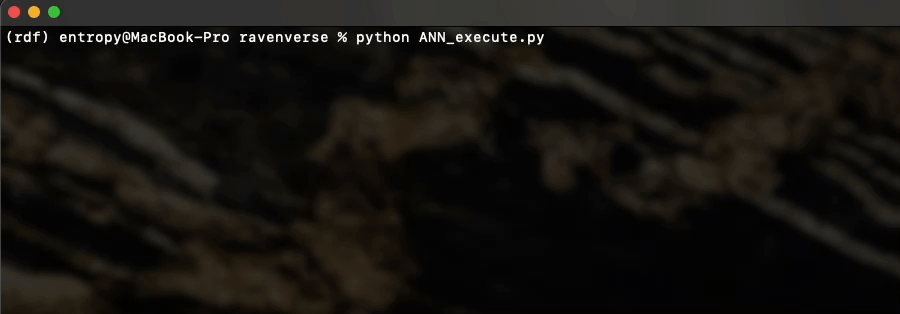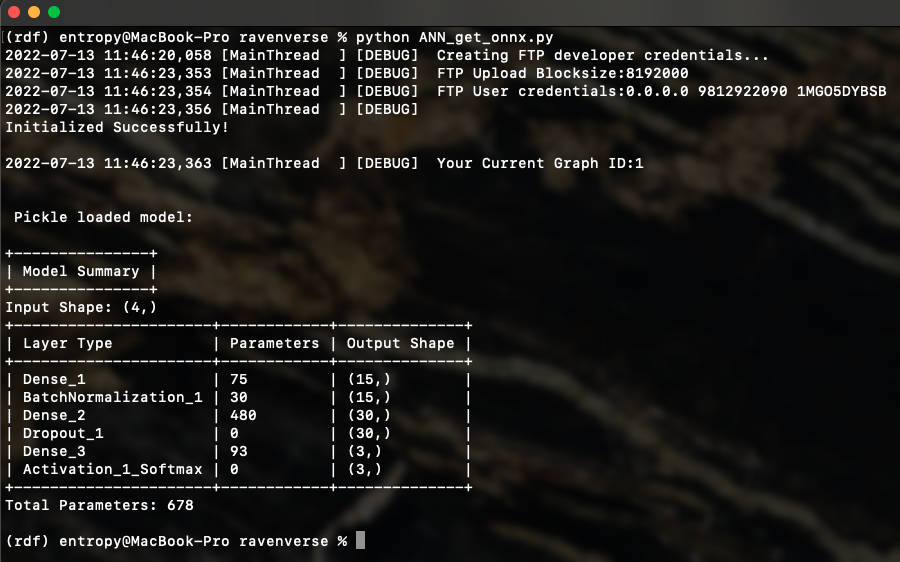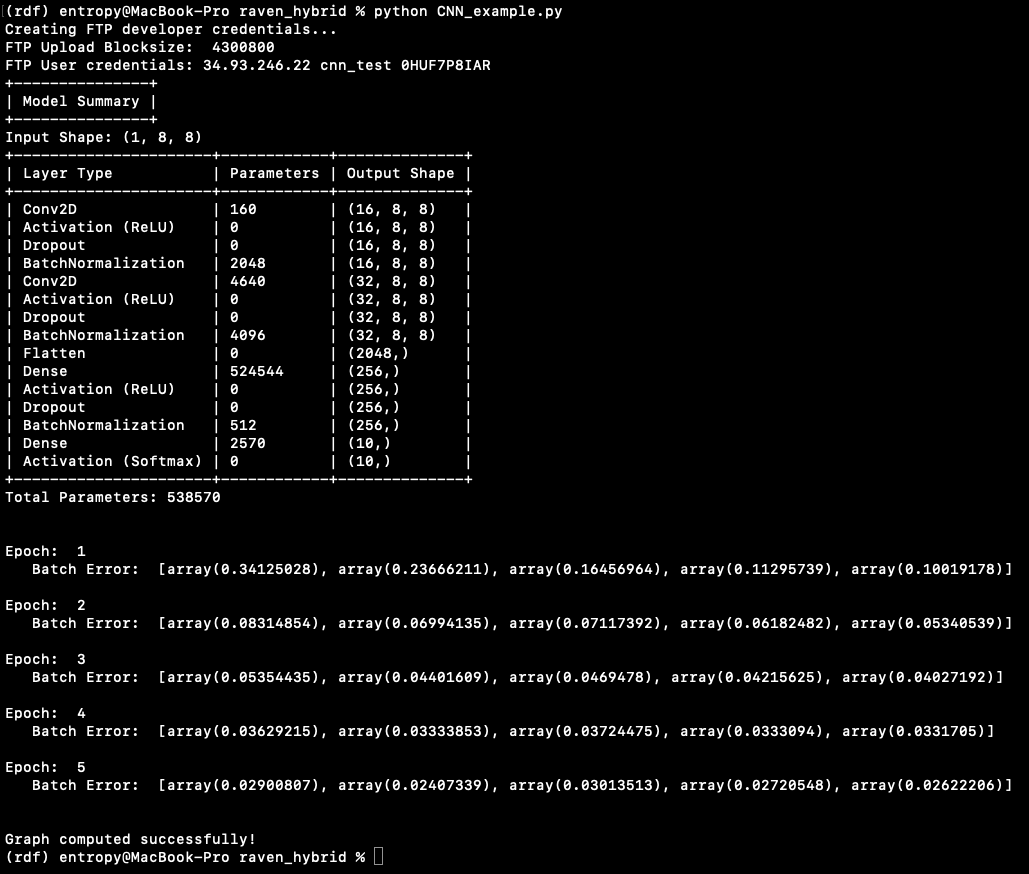No project description provided
Project description
RavDL - Deep Learning Library
Introducing Raven Protocol's Distributed Deep Learning tool that allows Requesters to easily build, train and test their neural networks by leveraging the compute power of participating nodes across the globe.
Working
RavDL can be thought of as a high level wrapper (written in Python) that defines the mathematical backend for building layers of neural networks by utilizing the fundamental operations from Ravop library to provide essential abstractions for training complex DL architectures in the Ravenverse.
This framework seemlessly integrates with the Ravenverse where the models get divided into optimized subgraphs, which get assigned to the participating nodes for computation in a secure manner. Once all subgraphs have been computed, the saved model will be returned to the requester.
In this manner, a requester can securely train complex models without dedicating his or her own system for this heavy and time-consuming task.
There is something in it for the providers too! The nodes that contribute their processing power will be rewarded with tokens proportionate to the capabilities of their systems and duration of participation. More information is available here.
Installation
Make sure Ravop is installed and working properly.
With PIP
pip install ravdl
Clone
git clone https://github.com/ravenprotocol/ravdl.git
Features
Layers
Dense(n_units, input_shape)
Activation(name='relu')
BatchNormalization(momentum=0.99)
Dropout(p=0.2)
Conv2D(n_filters, filter_shape, padding='same', stride=1)
Flatten()
MaxPooling2D(pool_shape, stride=1, padding='same')
Note: That the input_shape parameter needs to be given only for the 1st layer of the model.
Optimizers
RMSprop(learning_rate=0.01, rho=0.9)
Adam(learning_rate=0.001, b1=0.9, b2=0.999)
Activation Functions
- Sigmoid
- Softmax
- Tanh
- Relu
Losses
- MSE
- CrossEntropy
Usage
This section gives a more detailed walkthrough on how a requester can define their ML/DL architectures in Python by using RavDL and Ravop functionalities.
Note: The complete scripts of the functionalities demonstrated in this document are available in the Ravenverse Repository in the
ANN_exampleandCNN_examplefolders.
Authentication and Graph Definition
The Requester must connect to the Ravenverse using a unique token that they can generate by logging in on Raven's Website using their MetaMask wallet credentials.
import ravop as R
R.initialize('<TOKEN>')
In the Ravenverse, each script executed by a requester is treated as a collection of Ravop Operations called Graph.
Note: In the current release, the requester can execute only 1 graph with their unique token. Therefore, to clear any previous/existing graphs, the requester must use
R.flush()method.
The next step involves the creation of a Graph...
R.flush()
algo = R.Graph(name='cnn', algorithm='convolutional_neural_network', approach='distributed')
Note:
nameandalgorithmparameters can be set to any string. However, theapproachneeds to be set to either "distributed" or "federated".
Setting Model Parameters
RavDL currently has 2 versions: v1 and v2. The more recent v2 version is more efficient and faster than v1. However, v1 is more stable and has more features. Therefore, the requester can choose which version to use by adjusting the import statements in their scripts.
Version 1
from ravdl.v1 import NeuralNetwork
from ravdl.v1.optimizers import RMSprop, Adam
from ravdl.v1.loss_functions import SquareLoss
from ravdl.v1.layers import Activation, Dense, BatchNormalization, Dropout, Conv2D, Flatten, MaxPooling2D
model = NeuralNetwork(optimizer=RMSprop(),loss=SquareLoss)
Version 2
from ravdl.v2 import NeuralNetwork
from ravdl.v2.optimizers import RMSprop, Adam
from ravdl.v2.layers import Activation, Dense, BatchNormalization, Dropout, Conv2D, Flatten, MaxPooling2D
model = NeuralNetwork(optimizer=RMSprop(),loss='SquareLoss')
Adding Layers to Model
model.add(Dense(n_hidden, input_shape=(n_features,)))
model.add(BatchNormalization())
model.add(Dense(30))
model.add(Dropout(0.9))
model.add(Dense(3))
model.add(Activation('softmax'))
You can view the summary of model in tabular format...
model.summary()
Training the Model
train_err = model.fit(X, y, n_epochs=5, batch_size=25, save_model=True)
By default, the batch losses for each epoch are made to persist in the Ravenverse and can be retrieved later on as and when the computations of those losses are completed.
In ravdl.v1, the save_model parameter can be set to true if the trained model needs to be retrieved later for inference or further training.
In ravdl.v2, the persist_weights parameter can be set to true to make the weights persist in the Ravenverse for future use.
Note: It is recommended that the model object be saved as a pickle file in order to load the saved weights later on.
import pickle as pkl
pkl.dump(model, open("model.pkl", "wb"))
Testing the Model on Ravenverse
If required, model inference can be tested by using the predict function. The output is stored as an Op and should be made to persist in order to view it later on.
y_test_pred = model.predict(X_test)
y_test_pred.persist_op(name='test_prediction')
Activating the Graph
Once the aforementioned steps have been completed and all required Ops for the Graph have been defined, then Graph can be activated and made ready for execution as follows:
R.activate()
Here is what should happen on activating the Graph (the script executed below is available here):
Executing the Graph
Once the Graph has been activated, no more Ops can be added to it. The Graph is now ready for execution. Once Ravop has been initialized with the token, the graph can be executed and tracked as follows:
R.execute()
R.track_progress()
Here is what should happen on executing the Graph (the script executed below is available here):
Retrieving Persisting Ops
As mentioned above, the batch losses for each epoch can be retrieved as and when they have been computed. The entire Graph need not be computed in order to view a persisting Op that has been computed. Any other Ops that have been made to persist, such as y_test_pred in the example above, can be retrieved as well.
batch_loss = R.fetch_persisting_op(op_name="training_loss_epoch_{}_batch_{}".format(epoch_no, batch_no))
print("training_loss_epoch_1_batch_1: ", batch_loss)
y_test_pred = R.fetch_persisting_op(op_name="test_prediction")
print("Test prediction: ", y_test_pred)
Note: The Ops that have been fetched are of type int, float or list.
Saving the Model from RavDL to Onnx
If the save_model parameter has been set to True in the model.fit function, the model can be loaded as an Onnx model after Ravop has been initialized with the token.
Note: As of now, only
ravdl.v1has support for exporting/importing models to and from the ONNX format.
The persisting weights and biases of the trained model will be loaded onto the Onnx model.
test_model = pkl.load(open("model.pkl", "rb"))
print("\n\n Pickle loaded model: \n")
test_model.summary()
test_model.get_onnx_model("test_ann")
The get_onnx_model function takes the name of the onnx file, in which the model must be saved, as parameter. In this case it will be saved as "test_ann.onnx".
Note: As mentioned above, a
ravdl.v1.NeuralNetworkinstance with the same architecture as the saved model is required for loading the model. Hence it is recommended to save the model object as a pickle file.
The script executed below, to load the Onnx model, is available here.
Now the Onnx model can be tested and fine tuned locally. An example inference made with a loaded Onnx model is shown below.
import onnx
import numpy as np
import onnxruntime as rt
model_file_path = "test_ann.onnx"
# Test onnx model
sess = rt.InferenceSession(model_file_path)
input_name = sess.get_inputs()[0].name
input_shape = sess.get_inputs()[0].shape
batch_size = 1
dummy_input = np.random.random(
(batch_size, *input_shape[1:])).astype(np.float32)
prediction = sess.run(None, {input_name: dummy_input})[0]
print(prediction)
Loading an Onnx Model to RavDL
RavDL now supports loading a pre-existing Onnx model into RavDL (for supported layers).
from ravdl.neural_networks.load_onnx_model import load_onnx
model = load_onnx(model_file_path="test_cnn.onnx", optimizer=Adam(), loss=CrossEntropy)
model.summary()
In the above code, the model obtained from the "test_cnn.onnx" file is an ravdl.neural_networks.NeuralNetwork instance that can further be trained or used for making predictions in the Ravenverse.
Note: As of now, Onnx files exported from
.pt/.pth(Pytorch) or from RavDL are supported.
Examples
Training a Convolutional Neural Network
A sample CNN network to be trained on Sklearn's load_digits dataset is available here.
License
This project is licensed under the MIT License - see the LICENSE file for details
Project details
Download files
Download the file for your platform. If you're not sure which to choose, learn more about installing packages.
















